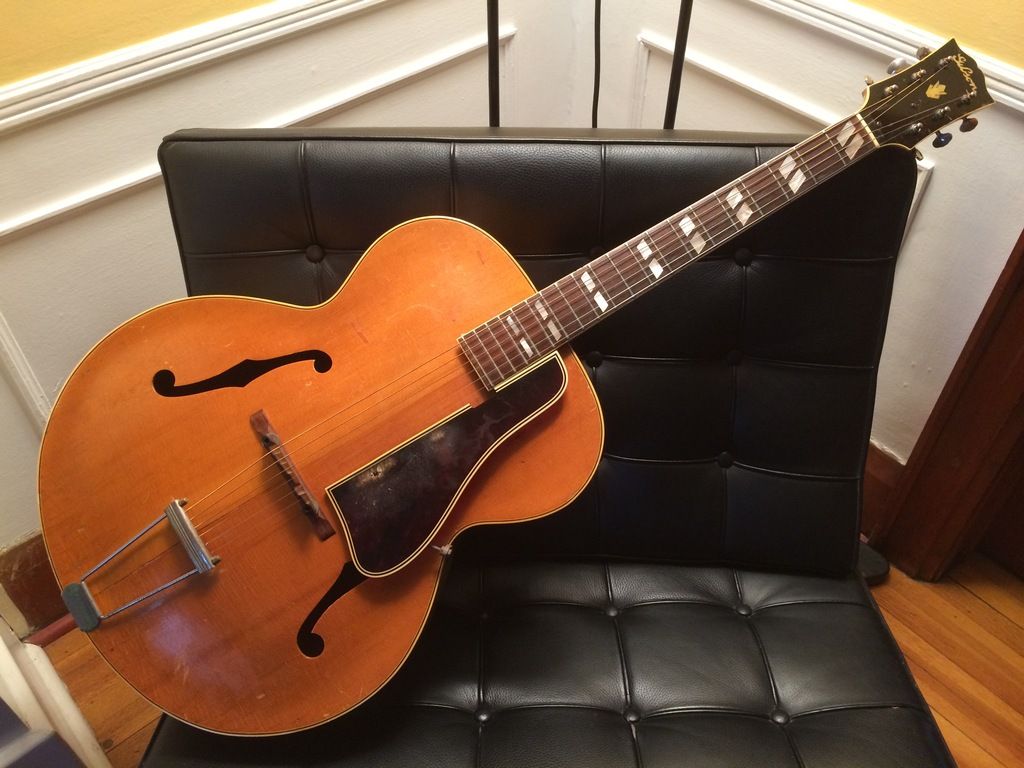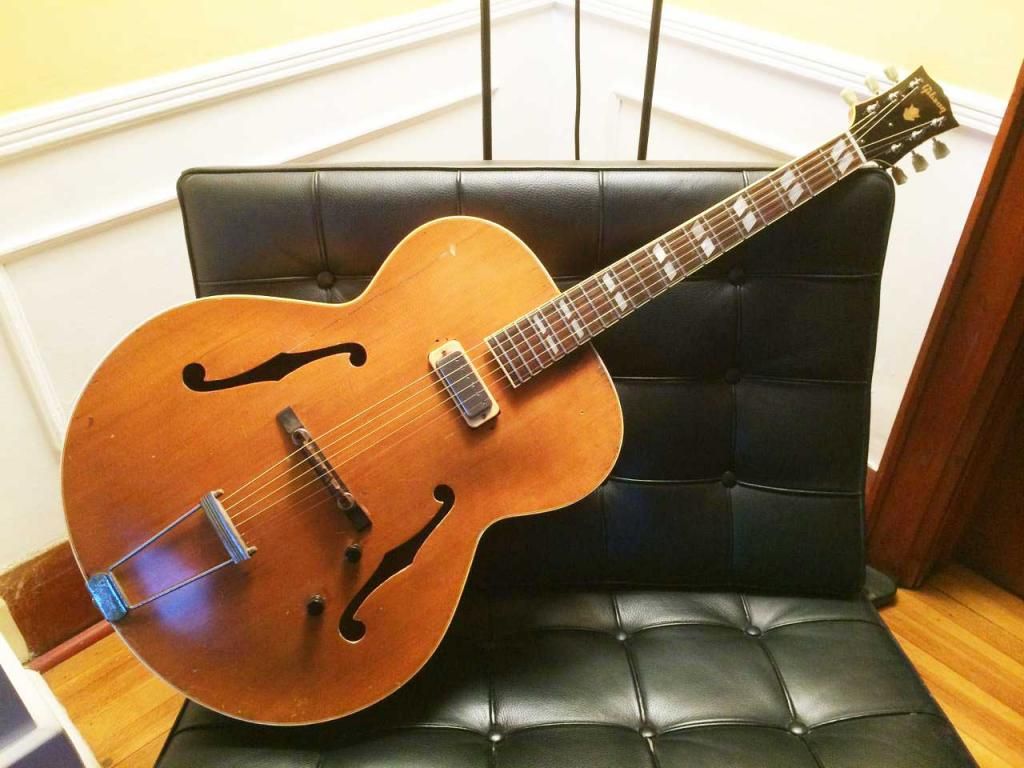-
Most unfortunate, but perhaps unsurprising given the guitar's period of lying unused.
-
01-19-2015 09:23 PM
-
In New Jersey I pump at least 7 gallons of water each day into my 15x15 guitar room, just to keep it at around 40-45%. You can't underestimate the amount of moisture guitars need. The more you pump into the air, the more they absorb, the healthier they remain. I'm sorry about the top of your L7. It can be sealed and repaired. I would start by replenishing the lost moisture by getting a hi capacity humidifier and soak it for the next couple of months. This will help it from sustaining further damage.
Joe D
-
So here is the completed guitar. Got it back today and the pickguard and the electronics are finished. Really happy how it turned out. Appreciate the advice and the info along the way.
-
Beautiful. So you kept the Lawrence as Rpguitar advised. A wise choice. Those are fine pickups. She'll be a fine gift to your nephew someday. Enjoy!
-
That's a classic Beauty.
Enjoy it. Keep it moist!
Joe D
-
Fine, fine guitar. The man who inspired me to take up playing jazz way back in 1980 had almost exactly that same guitar- a 40s L-7 natural with a Lawrence A-400 pickup. That could almost be the very same instrument. It sounded just great through Bill's Pro Reverb. That is an instrument that is ready to be enjoyed for another 70 years. I love seeing guitars like this brought back to life for a new generation!
-
This 1944 Gibson L-7 will be moving in with me this week. I'm really excited about it.
After she's had a chance to settle in and get comfortable, I'll post some pics. The seller's pics are not that good. Comes with original case. Aside from worn finish on the neck, and some dings and a repaired crack in the back, she looks amazing. The price was right so I pulled the trigger, having always wanted an old Gibson.
I'll need a pick guard and attaching hardware. Everything else looks original. Seller said neck angle and string height were good, so I can't wait to see for myself.
Interesting history on these in that they were built by the 'Gibson Gals' during WWII.
Does anyone have any more info on how many guitars Gibson made in 1944, and how many L-7s? That would be interesting to know about.
-
Looks like you scored! That's really nice and such a great era for gibson!
-
Not to steal the thunder from your NGD but this is what a 1947 L12 looks like:
Last edited by Jabberwocky; 03-22-2015 at 02:48 PM.
-
The butter bean tuners, the 3 piece neck, and no cracks on the solid carved spruce top put me over the top. And, original finish. I couldn't help myself.
If anyone has data on the number of L-7's and other gibsons produce those years, I'd love to know more history about them.
Thanks
-
1944?
From what I've been told Gibson did not make many guitars at all during 1944 ... or during the rest of WWII
They were working war contracts for most of the war .... mainly wooden parts for gliders ... if my sources were correct
-
That is correct. Not many. And, they were made by women, the Gibson Gals. They were really good with the wood. Please read the history.
-
IIRC Some of these wartime models have a trussrod cover, but there is no actual trussrod underneath.... Because of the metal going to the war effort.... Better make sure !!!
-
The last serial number for 1943 was 97800 the last serial number for 1944 was 98300. Total of 500 guitars made in 1944. I don't have a breakdown of L7 production.
-
That's something I hadn't considered. Thanks for that point FWS6. My luthier (that has a great ring to it, like I have my own private luthier) told me over the phone that regardless of truss rod adjustments most of these old gibbies need a neck set and fret job to really have a nice guitar. I kind of swallowed hard at that and called the seller back and asked more details about the angle and setup of the neck, which he claimed were in spec and had plenty of room on the bridge adjustment. Never asked whether it had a truss rod under the truss rod cover. Maybe I'll call tomorrow and ask. The Luthier also said that the L7 was his favorite vintage archtop. That made me feel good, but I was thinking I hope it wasn't because it was going to be in his shop and make his living for a week (ha!).
 Originally Posted by fws6
Originally Posted by fws6
Some other interesting things I noticed is that the label appeared to be the type used on earlier models, like late 30's, the logo seemed earlier, not slanted, and the tailpiece definitely has less metal. The screws are slotted and not phillips, also an indicator of earlier models. Gibson had to dip into earlier inventory during this period for parts supply. One researcher on this period at Gibson showed that there was more attention to detail in fitting braces and sanding parts his book claimed. I guess I'm going to find out soon enough about the truss rod, and if it doesn't have one, I'll probably still buy it, if it plays fine. We'll see. I'm still excited.
-
Thanks Archtop Guy, that's good info to have. It was number 98249 that year.
 Originally Posted by Archtop Guy
Originally Posted by Archtop Guy
-
Although their of no official logs of Gibson wartime archtops, they certainly did make guitars. I used to have an early '45 L-5. My current is a '46, still before they restarted production.
There is a gap in serial numbers between '41 and '47 in official company records, but the ones that were made off the books still had consecutive numbers. I don't know of a way to tell what year they were other than approximately. One story I've heard repeated is that it wasn't just the Gibson girls making them, but the older, undraftable males, either semi-officially with management consent, or perhaps even for friends and families. I've never heard a story of how they were sold or distributed.
-
-
My L7 is a C and it's not vintage (2006) but I will say this, I've never bonded with a guitar more than I've bonded with my L7c. It has the underdog factor that made me get close it. I love mine. I hope you feel the same about yours too!
Joe D
-
Congratulations, skykomishone! That looks lovely!
My L7 is serial number 98519. Somehow I always understood it to be a 1944. Not sure why. Maybe the seller mentioned it? But if the numbers upthread are correct, I guess it must be a 1945. No matter. It plays and sounds great!
-
Here are a couple before and after shots of my new favorite guitar that I snagged in a deal on Gbase several months ago. I was missing a pickguard, and needed frets and a neck reset and refinish. It did have a truss rod in good functioning order which was good to find out. I'm in absolute love with this guitar. As you can see from the before neck picture it has been seriously played, which was one of my first clues that this guitar must be a real player. Well, it is once again. No cracks in either top or back. Some dings here and there, but it plays and sounds fantastic. I've always wanted an old Gibson, and now I have a keeper.
The luthier said that it appears to be a prewar Gibson from the looks of how it is built, but assembled in '44 using cheaper tailpiece because of the war effort. I replaced the tailpiece and added the new pickguard and hardware. Strung with .013's bronze, it absolutely sings.
-
Not sure if i would have gone for the refinish..... looks like a great guitar still and I hope you will play down the finish to what it was before ;-)
-
Beautiful guitar. Congratulations. I hope you have many years of playing on it. Personally, I think the neck refin looks superb.
-
At one point in this lovely guitar's life someone had painted the back of the headstock and neck, also getting some of the black paint on the hardware. It looked shitty, despite the vintage cool thumb ware look. So, the neck finish was not original to start with, and I wanted to have something done. One of things I decided to do also, while the neck was off of the guitar, was reshape it to a more modern thickness. I'm sure you've played these baseball bat necks. It was impossibly thick, more like a Louisville Slugger. It was not fun to play, very difficult. Now, it's a home run! I expected it needed the neck set before I bought it, based on what my luthier told me about these old guitars. 70+ years, I'm about due for one myself. Also, they put these banjo wire frets on them back then.
-
Sweet axe !!! The restoration looks very natural. Nice job.




 Reply With Quote
Reply With Quote









Playing live and getting the best sound from the...
Today, 02:08 PM in Guitar, Amps & Gizmos